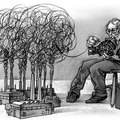INCHON, South Korea — All was quiet in South Korea’s nonbustling Chinatown on a recent weekday. The lunchtime trickle was over, leaving the streets as deserted as they had been in the morning. The shiny arches, red lanterns and towering “Welcome to Chinatown” sign, meant to impress visitors, seemed instead to magnify the neighborhood’s inactivity.
Hoping to lure Chinese investors and some of the ever-growing number of Chinese tourists, the local government in Inchon, just west of Seoul, four years ago transformed a tiny dilapidated Chinese neighborhood into the country’s first Chinatown.
In no time, officials in half a dozen other cities across the country announced plans to build their own Chinatowns, but none have progressed very far because of a host of obstacles ranging from a lack of capital to, well, a shortage of Chinese residents.
Even here in Inchon, the site of a Chinese settlement dating from the 1880s, there are only about 400 Chinese. Most of the several thousand who had been here during the last century left when South Korea, ever wary of its neighbor’s designs, curtailed their ability to do business.
China’s rise, as well as the growing wealth of both Chinese and overseas Chinese, has given birth to new Chinatowns in places as varied as Las Vegas; Dubai; Belgrade, Serbia; and Dobroiesti, Romania. But for South Koreans, Chinatown plans are fraught with historical subtext.
Sitting on the rim of the Middle Kingdom, Koreans kept the Chinese out of their peninsula for centuries as immigrants from China set up thriving Chinatowns throughout Asia and the Western hemisphere. Even Japan, which has had strained relations with China in modern times, is home to three thriving Chinatowns.
“Korea is so close to China, not even an hour away by plane, so that makes it even odder that there has never been a full-fledged Chinatown,” said Yi Jung-hee, a South Korean expert on the overseas Chinese and the author of “A Country Without a Chinatown.”
“Korea had its own identity but always felt the need to protect itself from China,” added Mr. Yi, who is now an assistant professor at Kyoto Sosei University in Japan.
It was during Korea’s weakest period that China’s presence here reached its peak. In the 19th century, Japan and China fought to gain influence over the Korean Peninsula. They, along with Western nations, wrested concessions in Inchon, establishing settlements dedicated to commerce and not subject to Korean law.
Japan eventually colonized Korea, but Chinese merchants and laborers kept gravitating here; several thousand lived here by the end of Japanese rule in 1945.
In the decades that followed, Chinese residents ran businesses here and in the heart of Seoul. But in the 1960s and 1970s, under the military rule of Park Chung-hee, South Korea carried out policies intended to curb Chinese business activities and restrict land ownership, leading many Chinese to emigrate to Taiwan or the United States. Those remaining were effectively restricted to running Chinese restaurants, especially those that served chajangmyon, a popular noodle dish with a black-bean sauce.
“When I was growing up here, this was the darkest and most impoverished area of Korea because all the Chinese had left,” said Fan Yenchiang, 48, owner of Tae Rim Bong restaurant here.
By early this decade, only a couple hundred Chinese residents were left.
But by then, South Korea’s trade with China was booming, and Inchon officials were working on turning this historic footnote into a full-grown Chinatown. The authorities aggressively courted Chinese investors and invested about $18 million to put up signs and lampposts and to build a cultural center. Local governments in China donated a statue of Confucius, as well as three arches leading into the neighborhood.
“In Chinatowns across the world, merchants themselves band together to raise the funds to build arches,” said Chae Jin-kyu, a city planning official. “But this may be the only Chinatown in the world whose arches were donated by mainland China.”
The placement of one arch became knotted with the local history. Shandong Province asked that its arch be erected in a spot that was near the local government office, which also happened to be inside the former Japanese concession.
Some Korean residents objected that it was too close to the local government office; others saw the request as China’s backhanded retribution to Japan for earlier humiliations. The arch was put elsewhere.
“This was their idea of settling scores from a 100 years ago,” said Cho Woo-sung, 59, a newspaper columnist and a local historian. “This was just China trying to show off its new power.”
“This is not a real Chinatown,” Mr. Cho added. “It’s a creation of the local government — very shallow and artificial. What is this? Do Chinese come here? No. There’s nothing beautiful here. Plus the parking’s terrible.”
The Chinatown’s fitful progress reflects South Korea’s larger ambivalence toward a re-emerging China.
South Korea has been strengthening ties with its big neighbor in recent years. China is now South Korea’s No. 1 trading partner; South Koreans are studying Chinese in droves; many see eye to eye with China on how to handle problems like North Korea.
Still, South Korea’s embrace of China has been tempered by the historical fear that it could be suffocated. China’s claim in recent years to Koguryo — an ancient kingdom that straddled the Korean Peninsula and northeastern China, and which Koreans regard as an integral part of their history — sharpened those fears.
So how much of Korean territory are Koreans willing to cede for the sake of Chinatowns? Can you build a Chinatown without Chinese?
“Chinatowns should be where the Chinese live,” Sun Meiling, 40, a third-generation Chinese-Korean, said emphatically.
Ms. Sun, 40, who owns three shops here with her husband, had left South Korea to do business in China for a decade. “But in 2002 we heard that they were building a Chinatown in Inchon, so we decided to come back,” she said.
Mr. Fan, the restaurant owner, leads a local merchants’ association that has 73 members. It includes 50 new arrivals from China, though the number is only a small fraction of what the authorities had hoped to attract.
He said that obtaining visas was a big obstacle and that a mainland Chinese businessman’s plan to open a foot massage center had fallen through because he could not get visas for Chinese therapists.
“If this Chinatown is to become a real Chinatown,” he said, “we must bring back the people who left or bring in new people. How can we call this a Chinatown if there are no Chinese here?”




